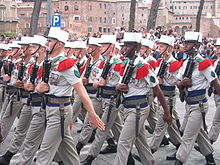Lock step
The term lock step refers to the synchronous leg movement of two or more people.
They can be installed in a row or in a line . The marching pace is measured in floor movements of the left leg per minute.
The lock step is particularly used by the military to practice discipline when exercising and to demonstrate unity during parades . Civil music bands also use lockstep for public parades. With it it is possible to move a large group of people in a confined space.
Historically, the lock step can already be traced back to ancient Greece, where it served to strengthen the attack force of the hoplite phalanx . In the first book of his main work De re militari , the Roman war theorist Vegetius describes the importance of lockstep.
National traditions
Germany
The lock step was first introduced in Germany by Prince Leopold I of Anhalt-Dessau in the Prussian army .
In the Bundeswehr today, a step frequency of 114 steps / min. and a stride length of 80 cm is required. Start with the left foot on the command: “In step - march!” The command is held with the announcement: “ Department - stop! “, Where the stop is the execution command when the right foot is on the ground. Then the left foot is moved forward.
The Prussian goose step (there parade step ) was after the Second World War only by the NVA kept. This was marched at the traditional pace of 114 paces / min. The step rate is 120 steps per minute.
Austria
In the Austrian Armed Forces, “In the step - march!” And “(the respective formation - group / platoon / company) - Halt!” Are used, as with every command , the command consists of an announcement (spoken long and drawn out) and a Execution part (spoken briefly and concisely).
Switzerland
In the Swiss Army, lock step is presented in the train school. The command is “forward - march”. As with every command, the order consists of an announcement (e.g. "Platoon!", "Company!") And an execution part (spoken briefly and concisely). The step rate is 120 steps per minute.
Other nations
In the UK, the stride length and number of strides / minute vary depending on the regiment and music that is being played with the march. There is the standard quick march as a quick march at 120 paces / min., Light infantry regiments march at 140 paces / min. and the Highland regiments 112 paces / min.
In France, the default is 110 steps / min. used. Only the Foreign Legion used an extremely slow pace - and marching in parade and march-past , therefore, last.
The standard marching pace used in the United States is the Quick March . This sees a pace of 120 steps / min. at a stride length of 30 inches (about 75 centimeters).
A lock step, which is related to the Prussian goose-step, is still used today by the armed forces of numerous communist or formerly communist states, e.g. B. Russia, the People's Republic of China , North Korea or armies in Africa. In the former Soviet Union or Russia, 120 steps / min. common.
Resonance effects
The rhythm of the evenly stamping feet can generate considerable vibrations, which in extreme cases, if the step frequency hits the resonance frequency , can cause a bridge to collapse (see resonance catastrophe ); Therefore, according to Section 27 (6) of the German Road Traffic Act, lockstep is prohibited on bridges. The command in the Bundeswehr for this is "without step (march)!".
See also
Web links
References and comments
- ↑ Lock step in Duden-Online
- ↑ footnote 4 to no. 415 of the structure no. 4.1.3 of the Bundeswehr Central Guideline (ARM regulation A2-221 / 0-0-1280), status: January 1, 2015 ( full text ( memento of the original from January 18, 2016 in the Internet Archive ) Info: The archive link was inserted automatically and not yet checked. Please check the original and archive link according to the instructions and then remove this note. (PDF)); by January 31, 2014: footnote 4 to no. 415 of the structure no. 4.1.3 of the ZDV 3/2 formal service regulations ("You must always march" without step "on bridges.")


